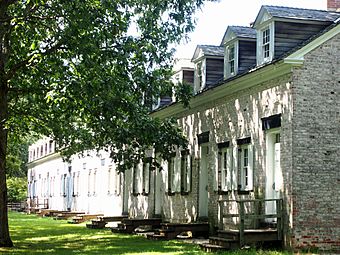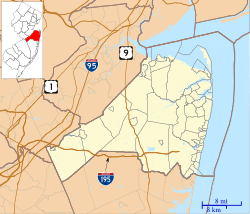Allaire Village facts for kids
Quick facts for kids |
|
|
Allaire Village
|
|
 |
|
| Location | 3 mi. SE of Farmingdale on CR 524, Farmingdale, New Jersey |
|---|---|
| Area | 330 acres (130 ha) |
| Built | 1750 |
| NRHP reference No. | 74001174 |
| Added to NRHP | January 11, 1974 |
Allaire Village is a special kind of museum called a living history museum. It's located inside Allaire State Park in Monmouth County, New Jersey. Here, you can step back in time and see what life was like in the 1830s.
Long ago, the land was used by Native Americans. By 1750, a sawmill was built there. The area later became a town built around a furnace that melted a special kind of iron called bog iron. In 1822, a man named James P. Allaire bought the town. He wanted to create a complete community where workers lived and had everything they needed.
The iron business eventually failed, and the village closed down in 1846. At its busiest, about 500 people lived and worked there. After it closed, the village was mostly abandoned. Later, the Boy Scouts used it as a summer camp and began to fix up the old buildings.
Today, Allaire Village is run by a non-profit group. People dress in old-fashioned clothes and show visitors how things were done in the 1800s. You can watch them work in the blacksmith, tinsmith, and carpentry shops. The village is a popular spot for events, weddings, and flea markets.
Contents
The Story of Allaire Village
The history of Allaire Village is about a special natural resource and the man who built a community around it. This man, James P. Allaire, created a bustling town called the Howell Works. It was a key part of his business empire.
Allaire also owned a major engineering company in New York City that built steam engines for ships. By owning the Howell Works, he could control his business from start to finish. He got the raw iron from the ground in New Jersey and used it to build parts for his ships in New York.
An Industrial Boomtown
The village that visitors see today was built by James P. Allaire. It shows his vision for a perfect industrial town during a time of great change in America. This period, from the 1820s to the 1840s, is often called the Jacksonian Era.
During this era, America was becoming more industrial. Factories and machines were changing how people lived and worked. Allaire's village was a great example of this change. It was a self-sufficient community with a church, a school, a store, and homes for its workers.
The village's success was tied to the economy. When times were good, the village did well. But when the country faced its first major economic depression, called the Panic of 1837, the business struggled.
What is Bog Iron?
James P. Allaire was interested in the land because it had large amounts of bog iron ore. This type of iron forms in swamps and marshes. Before huge iron mines were discovered in mountains, bog iron was a very important resource.
Bog iron is easy to get because it's near the surface. You don't need to dig deep mines to find it. Allaire also knew the nearby forests would provide plenty of wood to fuel the furnace for melting the ore.
Amazingly, bog iron is a renewable resource. It forms when rainwater mixes with acids and iron particles in the soil. This mixture rises to the surface and hardens into a solid mass of iron ore. The whole process takes only about 25 to 35 years. This meant the furnace could have a nearly endless supply of iron if the land was cared for properly.
Bringing the Village Back to Life
After the ironworks closed in 1846, the village became quiet. Most of the buildings were empty and fell into disrepair. For a while, it was known as the "Deserted Village." In 1901, a wealthy newspaper publisher named Arthur Brisbane bought the property.
A New Purpose: Boy Scout Camp
In 1929, the land was rented to the Monmouth County Boy Scouts for a summer camp. The scouts found the buildings in very bad shape. They worked with local community groups to begin restoring them.
For example, a club helped fix up the general store. A local church restored the Foreman's Cottage to use as a first-aid station. The Boy Scouts and other groups used the camp for over ten years. A plaque on the General Store honors the work they did during that time.
Becoming a State Park and Museum
In 1941, Arthur Brisbane's widow, Phoebe, gave the land to the state of New Jersey. She wanted it to become a park in memory of her husband. For a while, the state didn't have the money to fix the village, and the buildings began to decay again.
Finally, in the mid-1950s, a non-profit group was formed to restore the village. They started with the Blacksmith Shop and the General Store. On May 24, 1958, Allaire Village officially reopened to the public as a museum.
Today, visitors can see the restored buildings and learn about New Jersey's industrial past. The village offers a rare chance to see what life was like in the early 19th century.
See also




